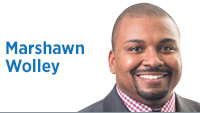Subscriber Benefit
As a subscriber you can listen to articles at work, in the car, or while you work out. Subscribe Now

Our city remains at risk without broad community engagement on the underlying factors that challenge police-community relations.
The national environment around police action shootings, particularly involving fatal shootings of black people, has stirred the conscience of the nation. Many cities are trying to figure out the way forward after suddenly being compelled to confront the confluence of racial and socioeconomic disparities erupting in neglected neighborhoods. These cities are learning that the two-city model—where the haves and the have-nots co-exist without connecting—has implications for the whole.
Shootings that might have been covered up are going viral on Facebook and turning into lead stories for the national media. One incident of bad policing no longer results in enhanced social control of a neighborhood—the pendulum has shifted to the possible indictment of an entire city.
Ferguson and Baton Rouge, Cleveland and Waller, Texas, are the new Birminghams and Selmas—battlegrounds in a new civil rights movement that at times feels like a civil war.
Indianapolis recently had an officer-involved shooting that fortunately was not fatal, but it shouldn’t have happened in the first place. IMPD quickly acknowledged the incident as a mistake. There was outrage, mostly on social media. No riots. I’m aware of one vigil.
Relative to other cities, the reaction from large segments of the community about the shooting of a black homeowner, who called the police for assistance but was instead shot by police, seemed muted.
Our collective response as a city raised a number of questions. I wonder if our national environment has begun to desensitize us and so, since the shooting wasn’t fatal, people felt like more outrage wasn’t required? Was the reaction relatively muted because IMPD apologized and the homeowner didn’t die? Are we just tired of this conversation?
Indianapolis, relative to other cities, has a number of community systems and sustained dialogues in place that operate behind the scenes for situations like this recent shooting. Did these systems and processes work?
The reality is that people processed the event within a broad continuum of reactions—from outrage over another “trigger-happy law enforcement officer” shooting black bodies, to questioning why a military-trained police officer would step outside with a weapon after calling the police in this particular situation.
Arriving at a community consensus that Indianapolis has strong police-community relations involves continuing the difficult work of both improving police training and developing shared definitions of what transparency and accountability should look like. Community organizations and activists are wrestling with these and other ideas now. But agreement on the status of police-community relations doesn’t change underlying concerns that threaten to disrupt order in the city. Addressing significant disparities in our community is the better sustainable approach to public safety long term. After all, any relationship is good until it is not.
When one considers the potentially explosive implications of steep declines in minority homeownership, accelerating poverty in some communities and social immobility problems juxtaposed against the city’s emergence as a convention city, the downtown development boom and strides in both arts and cultural as well as the tech industry, it can be easy to lose a sense of where we are as a city.
We need to appreciate the underlying socioeconomic, racial and historical factors affecting police-community relations—or risk failing to see ourselves, or worse, become the next battleground.•
__________
Wolley is a lecturer at the School of Public and Environmental Affairs at IUPUI.Send comments to ibjedit@ibj.com.
Please enable JavaScript to view this content.
